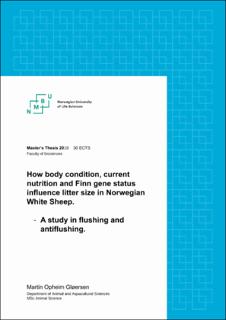| dc.description.abstract | The effect of body condition, current nutrition and Finn gene status on litter size was studied using 111 ewes of Norwegian White Breed, in the age from 1.5 to 6.5 years. The last 11 weeks before mating in mid-November the ewes were divided into three groups, where one group was fed to increase their body condition (BC), one was fed to keep a constant BC, and the last was fed to decrease BC. All groups were offered forage ad libitum as the sole feed, where forages differed considerably in energy concentration. Forty-eight of the ewes were stalled individually, whereas 63 were stalled in group pens. In addition to using the well-known body condition score (BCS) from 1-5 to describe the fatness of each ewe, also Body Mass Index (BMI) was calculated for each individual. Of the 111 ewes there were 41, 59 and 11 ewes with Finn gene status 0, 1 and 2, respectively. The litter size was registered with ultrasound measurement in January. Results showed a significant effect of BMI at mating (P<0.0001), giving an increase of 0.20 lambs per 10-point increase in BMI, or an increase of 0.26 lambs per increase in BCS (P<0.001). Finn gene status was significant in the BCS model (P=0.03) and tended to be significant in the BMI model (P=0.05), giving an extra of 0.30 and 0.27 lambs, respectively, for each increase in Finn gene status. Current nutrition, measured as daily changes in BCS or BMI before mating did not influence litter size significantly. The presence of Finn genes seemed to be more powerful on ewes in high BC than in low. There were significant differences in litter size between ewes in the Increasing diet as opposed to both the Constant (P<0.05) and Decreasing (P<0.01) diets. The High conditioned ewes (BCS > 3+) got significantly (P<0.01) more lambs (2.88 vs 2.13) than the Low conditioned ewes (BCS < 3-). On average, the 1.5-year-old ewes got 0.41 lambs less than the adult ewes. | en_US |

